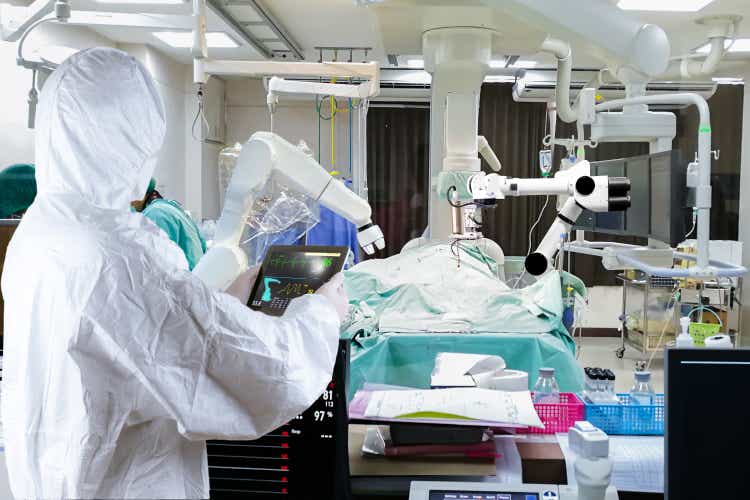sompong_tom
By Rick Bradt
A convergence of technologies is set to revolutionize how physicians examine the body for signs of cancer.
The official term for such searches is “endoluminal”—within a tubular organ or structure. Advances include the integration of CT scanning for preprocedural mapping of the search, 3D imaging, electronic rapid sensing to track the catheter, flexible ultrathin catheters and, in particular, the ability to use a computer to robotically control the placement of the device itself. The robotic placement and control of the catheter maximize precision and stability, at a level far beyond what surgeons could do on their own.
This utilization of robotically assisted surgical tools follows 20 years of momentum in using the same for soft tissue and orthopedic surgical procedures. Increasingly in the U.S., academic training in the use of robotic tools has become standard for many aspiring surgeons. What differentiates the opportunity with the flexible catheter is the minute nature of the cancer nodule, as well as the associated frequent challenge in reaching it. With breakthrough efforts in medical technology, the initial target is typically the one with the easiest path to market—thus the current application, lung bronchoscopy. According to many experts, its advantages are compelling: superior access to the peripheral lung, where approximately 70% of nodules reside, and the ability to biopsy upon discovery.
But given the nature of the integrated offering, we believe that lung biopsies comprise only the first frontier. And while roughly one million lung biopsies are performed annually in the U.S., with about 200,000 annual findings of lung cancer, that pales in comparison to the holy grail of this opportunity: the colonoscopy, with an estimated 15 million per year. Further, there is every reason to expect that future evolution of robotic endoluminal procedures could include the ability during the procedure to treat the cancer, either via ablation or with drugs.
The market currently has two competitors: Johnson & Johnson (JNJ) and Intuitive Surgical (ISRG). In health care, mainstream usage is predicated not just on technology, but on the combination of tech, FDA approval, payer coverage, and positive trial data at scale. The latter has been the missing link but could be addressed with a pending trial that showed preliminarily an 83% diagnostic yield, i.e., 83% of biopsies appropriate for diagnosis. Both J&J’s “Monarch” and IS’s “Ion” platforms have momentum: Monarch is conducting 2,000 procedures per quarter (or +100% year-over-year), while Ion is doing 5,000 (or +250% year-over-year). And Monarch has just received approval for its second indication, urological removal of kidney stones.
This material is provided for informational purposes only and nothing herein constitutes investment, legal, accounting or tax advice. This material is general in nature and is not directed to any category of investors and should not be regarded as individualized, a recommendation, investment advice or a suggestion to engage in or refrain from any investment-related course of action. Investment decisions and the appropriateness of this material should be made based on an investor’s individual objectives and circumstances and in consultation with his or her advisors. Information is obtained from sources deemed reliable, but there is no representation or warranty as to its accuracy, completeness or reliability. All information is current as of the date of this material and is subject to change without notice. The firm, its employees and advisory accounts may hold positions of any companies discussed. Any views or opinions expressed may not reflect those of the firm as a whole. Neuberger Berman products and services may not be available in all jurisdictions or to all client types. This material may include estimates, outlooks, projections and other “forward-looking statements.” Due to a variety of factors, actual events or market behavior may differ significantly from any views expressed.
Investing entails risks, including possible loss of principal. Investments in hedge funds and private equity are speculative and involve a higher degree of risk than more traditional investments. Investments in hedge funds and private equity are intended for sophisticated investors only. Indexes are unmanaged and are not available for direct investment. Past performance is no guarantee of future results.
This material is being issued on a limited basis through various global subsidiaries and affiliates of Neuberger Berman Group LLC. Please visit www.nb.com/disclosure-global-communications for the specific entities and jurisdictional limitations and restrictions.
The “Neuberger Berman” name and logo are registered service marks of Neuberger Berman Group LLC.
© 2009-2022 Neuberger Berman Group LLC. All rights reserved.
Editor’s Note: The summary bullets for this article were chosen by Seeking Alpha editors.


Be the first to comment